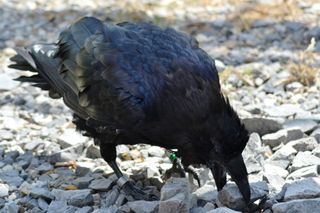Ravens Know When Food-Thieving Rivals Are Watching

In Norse mythology, two ravens named Huginn and Munnin — "Thought" and "Memory" — employ these faculties as Odin's emissaries, acting as the god's eyes and ears on Earth and reporting back to him about whatever they observe. Even in common ravens, problem-solving, decision-making and remembering past experiences are traits that scientists recognize as highly developed.
Now scientists have found that ravens seem to know when they're being watched by a rival that might steal from them, and then take steps to hide their food.
Previous behavior studies with scrub jays, which are raven relatives, showed that they could interpret other bird's thieving intentions — if they spied another jay watching them while they had food, they hid the food away.
But the scientists behind the new study wondered — did the jay with the food really know what the rival bird was "thinking?" Maybe it simply followed the other bird's gaze to conclude that it meant to steal from them. For the new study, the researchers wanted to see if ravens could reach the same conclusion without the benefit of visual clues. [The 5 Smartest Non-Primates on the Planet]
Complex interactions
Ravens are highly social birds and their interactions can be quite complex, according to the study's first author, Thomas Bugnyar, a cognitive biologist at the University of Vienna.
For ravens, Bugnyar told Live Science, foraging in itself can be a social activity, with birds recruiting their fellows to help them gain access to food. But more ravens means greater competition, and ravens commonly try to grab more than their share of a common food source by doing something called "caching" — setting food aside for later. So instead of hanging around and simply eating until it's full, a crafty raven will take food and hide it away, returning to the source to replenish the cache repeatedly, until all the food is gone, Bugnyar said. Ravens that aren't fast enough to get enough of the original food source often raid others' caches — if they can find them.
Sign up for the Live Science daily newsletter now
Get the world’s most fascinating discoveries delivered straight to your inbox.

According to Bugnyar, he and his colleagues noted in earlier experiments that the birds, in order to steal as efficiently as possible, closely watched other ravens that visited their caches over and over again, to add more food. "They have very good observational memory," Bugnyar told Live Science. "They remember caches they make themselves, and caches made by others." At the same time, ravens with thievery on their minds try to look like they're not watching too closely, which would make the cache-building ravens suspicious, Bugnyar said.
Cache as cache can
For the new study, scientists built two chambers connected by a wall with windows, which could be covered. In the first chamber, a raven received food. When the researchers placed a watchful raven rival in the second enclosure, visible to the first raven through the window, the first raven would guard its cache, replenishing it less frequently, so as to hide its position.
Then the researchers covered the window between the chambers. While the first raven still appeared to recognize there could be a potential thief nearby, it did not guard its cache of food as closely.
Finally, the researchers kept the window covered but left a peephole open. They removed the second raven, but played recorded raven calls as if there were still a rival hiding behind the covered window and possibly peering through the peephole to find the hidden food. Even though the first raven couldn't see the rival, and received no visual cues that it might be interested in the food, the first raven did not return to its cache as often as when the peephole was closed, and ate the cached food more quickly, the scientists found. [Raven-Whisperer Of Yellowknife Talks With Wild Bird]
They also noted that the ravens appeared to choose the position of their caches based on locations that were less visible from the vantage point of the peephole, and away from curious eyes.
The evidence indicates that ravens are capable of perceiving a threat from a thief even if they can't see them, according to Bugnyar. But this behavior represents only a small part of "raven politics," he told Live Science, adding that this behavior, rather than being restricted to the special context of competing for cached food, is likely part of the much bigger picture relating to ravens' complex social life.
The findings were published online today (Feb. 2) in the journal Nature Communications.
Follow Mindy Weisberger on Twitter and Google+. Follow us @livescience, Facebook & Google+. Original article on Live Science.

Mindy Weisberger is an editor at Scholastic and a former Live Science channel editor and senior writer. She has reported on general science, covering climate change, paleontology, biology, and space. Mindy studied film at Columbia University; prior to Live Science she produced, wrote and directed media for the American Museum of Natural History in New York City. Her videos about dinosaurs, astrophysics, biodiversity and evolution appear in museums and science centers worldwide, earning awards such as the CINE Golden Eagle and the Communicator Award of Excellence. Her writing has also appeared in Scientific American, The Washington Post and How It Works Magazine.
